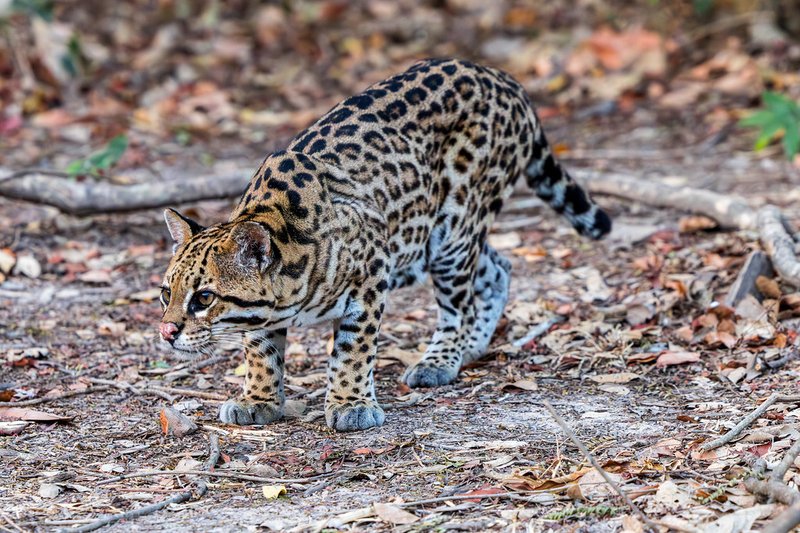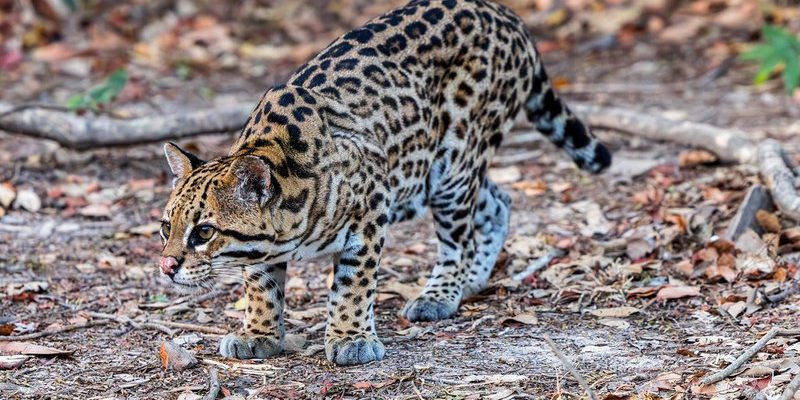
When you think of wild cats, you might picture lions or tigers. However, the ocelot brings its own unique charm to the feline family. Often dubbed “the little leopard,” this stunning creature showcases a blend of beauty and adaptability, thriving in various environments across the Americas. If you’ve ever seen a picture of its striking coat—marked by beautiful rosettes—you know why these cats are so captivating.
Ocelots are often the star of the show in the wild, demonstrating a fascinating blend of stealth and playfulness. They’re primarily nocturnal hunters, which means they do most of their prowling under the cover of darkness. Imagine wandering through a rainforest, the air thick with humidity, and suddenly—there it is! The sleek body of an ocelot, gliding silently among the shadows, with those mesmerizing eyes peering out from the underbrush.
Physical Characteristics
One of the most striking features of the ocelot is its beautiful coat. The pattern resembles that of a leopard but is smaller in scale. Their fur is typically a golden or cream base color, marked with rows of black spots and stripes. This not only aids in camouflage but also adds to their allure. Ocelots generally weigh between 20 to 35 pounds and measure about 28 to 35 inches in length, making them relatively small compared to other wildcats. They have long legs and a robust body, which contribute to their agility and hunting prowess.
Their large, expressive eyes are another notable feature. Equipped with excellent night vision, ocelots can see in low-light conditions, which is essential for their nighttime escapades. If you were to observe one closely, you’d notice how its ears—rounded and short—are designed to be highly sensitive to sounds, helping these cats locate prey even in dense foliage.
To summarize their physical traits, here’s a quick overview:
| Size: | 28 to 35 inches (head to body) |
| Weight: | 20 to 35 pounds |
| Coat: | Golden or cream with black rosettes |
| Habitat: | Tropical rainforests, savannas, and scrublands |
| Lifespan: | 10 to 15 years in the wild |
Habitat and Distribution
The ocelot’s range is primarily found throughout the Americas, from the southern United States all the way down to Argentina. They thrive in a variety of habitats, including tropical rainforests, grasslands, and scrublands. This adaptability is one of the reasons why ocelots have survived in the wild, even as their habitats face encroachment from human activities.
You might be wondering what it takes for ocelots to live comfortably in different environments. Their keen senses help them navigate both thick jungles and open savannahs. They’re often spotted near water sources like rivers and lakes, as these areas provide essential resources for hunting and drinking. By being adaptable, they can find cover in dense underbrush during the day, making it easier to hunt at night.
However, they face numerous threats that jeopardize their survival. Habitat destruction due to logging, agriculture, and urban expansion significantly reduces their natural territory. As ocelots lose their homes, their population becomes increasingly vulnerable, pushing them to adapt even further. Conservation efforts are critical to ensuring these magnificent creatures continue to roam the wild.
Diet and Hunting Behavior
Ocelots are skilled hunters, primarily feeding on small mammals, birds, reptiles, and even insects. They’re not picky eaters, which is beneficial in the wild where food availability varies. Imagine an ocelot quietly stalking its prey, moving with grace and stealth. This hunting strategy plays a significant role in their survival.
Their method of hunting involves a combination of ambush and stealth. Ocelots are known to employ a slow, low crawl, using their excellent camouflage to blend into their surroundings. Once they spot their target, they pounce with remarkable speed and agility. This technique helps them catch fast or flighty animals that would otherwise escape from larger predators.
During their nocturnal adventures, ocelots can cover substantial distances, often patrolling their territory for food. They rely on scent and sound to track their prey, showcasing an impressive combination of physical prowess and instinct. You can imagine them as the stealthy ninjas of the animal kingdom, skillfully maneuvering through their environment as they look for their next meal.
Social Behavior and Reproduction
Unlike some big cats that prefer solitude, ocelots tend to be more sociable. They don’t form strict packs or groups, but you may occasionally find them in overlapping territories. Their social structure is primarily dictated by mating behaviors and parental roles. Mating typically occurs during the breeding season, which can vary based on geographical location.
When it comes to reproduction, ocelots are known for their careful, nurturing instincts. After a gestation period of about 70 to 80 days, a female typically gives birth to one to three kittens. These little ones are born blind and rely heavily on their mother for survival in those early days. As the kittens grow, they begin to explore their surroundings, learning essential skills through play and observation.
The mother ocelot teaches her young not just how to hunt but also about marking territory. This early training is vital for their independence. By the time they reach six months, the kittens are weaned and start to follow their mother on hunts, gradually preparing to venture out on their own by the age of 1 to 2 years.
Conservation Status
One of the unfortunate realities for the ocelot today is that their population is in decline due to habitat loss and poaching. Classified as “Least Concern” by the IUCN, they still face significant threats from human activities. Conservationists are raising awareness about the importance of preserving their habitats and enforcing laws to prevent illegal hunting.
Efforts are underway to protect ocelots by establishing wildlife corridors that allow them to safely move between fragmented habitats. These passages are critical as they help maintain genetic diversity within the population, which is essential for their long-term survival. It’s heartening to know that dedicated organizations are working tirelessly to keep these beautiful cats safe, showing how collective efforts can lead to positive change in conservation.
Supporting local conservation initiatives can also make a difference. Even small contributions help protect the habitats that ocelots rely on. Whether through donations or volunteer work, anyone can play a part in helping preserve this magnificent species for future generations to admire.
FAQ
What is an ocelot’s lifespan in captivity versus in the wild?
In the wild, ocelots generally live between 10 to 15 years. However, in captivity, they can live significantly longer, often reaching up to 20 years or more due to better care and absence of threats such as hunting or habitat destruction.
Are ocelots solitary or social animals?
While ocelots are primarily solitary creatures, they do exhibit some social behaviors during mating seasons. They may share overlapping territories but do not form long-term bonds with other ocelots.
What are the main threats to ocelots?
The key threats to ocelots include habitat loss from deforestation, urbanization, and agriculture. Additionally, poaching poses a risk to their population, as they are hunted for their beautiful fur.
How do ocelots communicate with each other?
Ocelots communicate using a mix of vocalizations, body language, and scent markings. Their calls can include growls, meows, and purrs, which help establish territory and attract mates.
What do ocelots eat?
Ocelots are carnivorous and primarily feed on small mammals, birds, reptiles, and insects. Their diet can vary based on what is available in their habitat, showcasing their adaptability as hunters.
Are ocelots endangered?
Ocelots are classified as “Least Concern” but are still vulnerable due to habitat loss and illegal hunting. Efforts are ongoing to protect their populations and habitats to ensure they continue to thrive in the wild.
How do ocelots hunt?
Ocelots utilize stealth and patience to hunt. They often ambush their prey, using their excellent camouflage to blend into their surroundings and pounce at just the right moment.
Can ocelots be kept as pets?
Owning an ocelot as a pet is generally not advisable. They are wild animals with specific needs that are difficult to meet in a domestic setting. Additionally, in some regions, it may be illegal to keep them as pets due to conservation laws.
What is the role of ocelots in their ecosystem?
Ocelots play a vital role in their ecosystem as predators. By controlling the population of their prey species, they help maintain balance within their habitats, contributing to the overall health of the ecosystem.
How can I help protect ocelots?
You can help protect ocelots by supporting wildlife conservation organizations, spreading awareness about their plight, and participating in local environmental initiatives. Every small action counts in preserving their habitats.
Where can I see ocelots in the wild?
Ocelots are primarily found in areas of Central and South America, with some populations in southern Texas. National parks and wildlife reserves in these regions are the best places to observe them in their natural habitat.
Do ocelots have any natural predators?
While adult ocelots have few natural predators, they can fall prey to larger animals such as jaguars and crocodiles. Young ocelots are more vulnerable and may be hunted by various larger carnivores.

